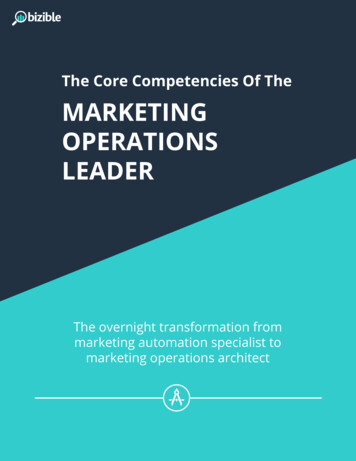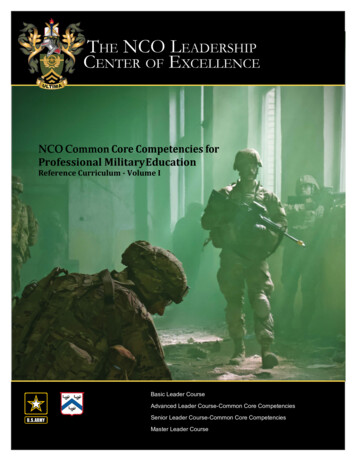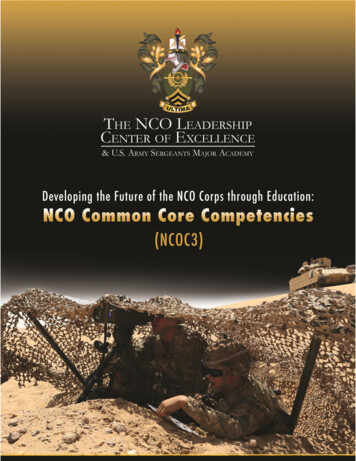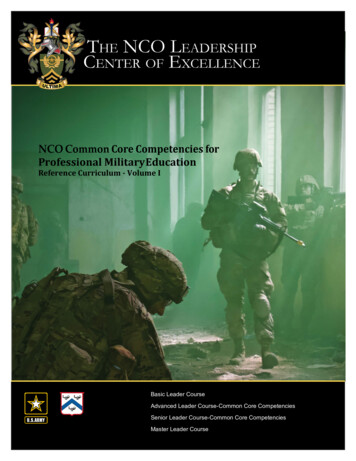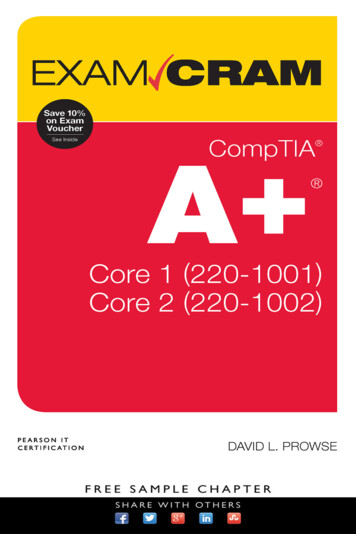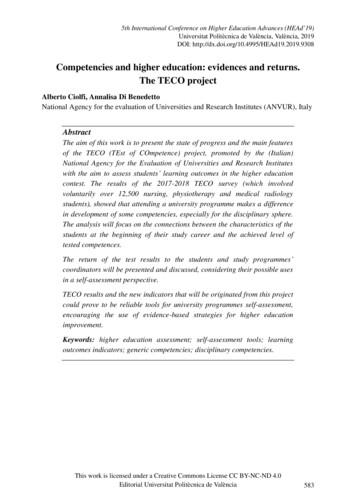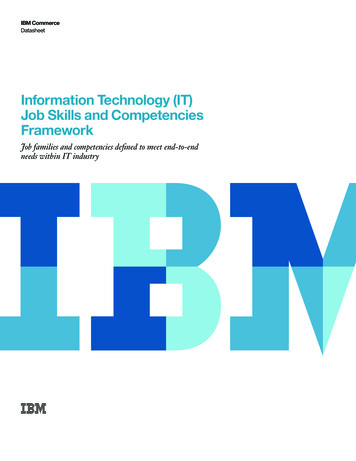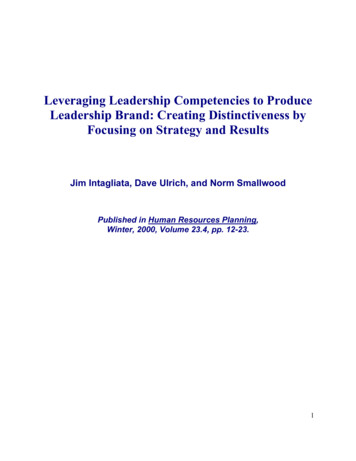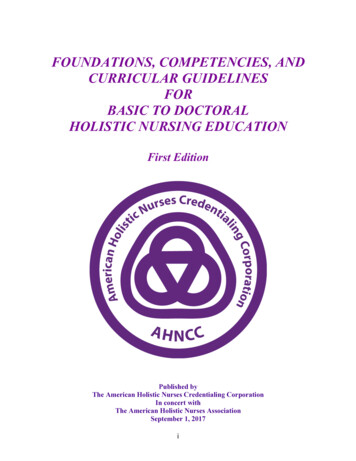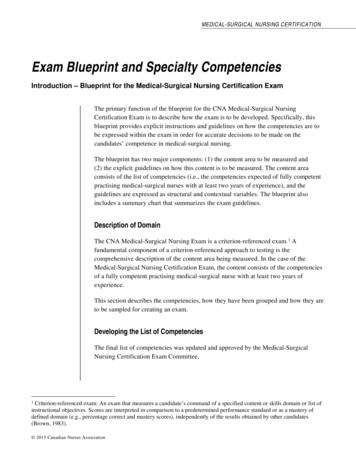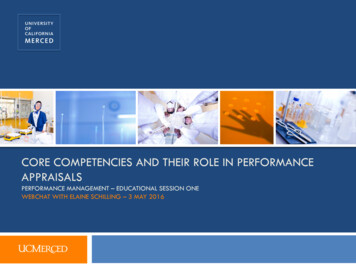
Transcription
CORE COMPETENCIES AND THEIR ROLE IN PERFORMANCEAPPRAISALSPERFORMANCE MANAGEMENT – EDUCATIONAL SESSION ONEWEBCHAT WITH ELAINE SCHILLING – 3 MAY 2016
Core Competencies and their role inperformance appraisalsAn overview of core competencies and how theyare used in performance appraisals
What is a Competency?It is a measurable pattern of skills, knowledge,abilities, behaviors and other characteristicsneeded to perform and fulfill one’s jobresponsibilities.
Core CompetenciesCompetencies are important for: Ensuring organizational success Enhancing employee contribution, performance Measuring job responsibilities and organizational citizenshipbehaviors, such as communication, teamwork and collaboration Illustrating two important factors: how well you perform your joband how well you perform your job in a team environment
Effects of Using Core CompetenciesOrganizationalresultsIndividual results(performance)BehaviorsCompetencies
Competency-based PerformanceManagementAddresses how a person accomplishes job responsibilitiesin addition to what a person accomplishes.Focus on bothHowCompetencies – organizationalcitizenship behaviorsWhatJob responsibilities
UC Merced Core onDiversity and inclusionEmployee engagementInnovation and change managementJob mastery and continuous learningResources management and sustainabilityResults orientation and executionService focusTeamwork and collaborationSolving problemsQuality assurance and assessmentPeople management (for managers)They speak to the skillsand behaviorsnecessary for personaland professionalsuccess.All employees shoulddemonstrate each ofthese competencies intheir day-to-day tasksand job responsibilities.
UC Merced Core onDiversity and inclusionEmployee engagementInnovation and change managementJob mastery and continuous learningResources management and sustainabilityResults orientation and executionService focusTeamwork and collaborationSolving problemsQuality assurance and assessmentPeople management (for managers)Halogen 2.0Performance Appraisal
UCM Core Competencies Rubric Guide Provides examples of what behaviors could look like andare not inclusive of all behaviors that demonstrate eachlevel of performance for the competency. The rubric is a tool to help guide evaluation of employeeperformance and should not be used as a checklist foremployees’ behavior. It is important to have discussions in your area/unit, so thateach person understands what each competency “looks like” on aregular basis – and how performance is being assessed.
UCM Core Competency - ExampleDIVERSITY AND INCLUSIONDescription:Models and promotes UCM’s Principles of Community and complies with UCPolicies on Diversity and Non-Discrimination.1.Demonstrates behaviors that include fairness, respect, inclusiveness,empathy, integrity, and ethical conduct.2.Fosters a climate and culture in which each person is accepted and has theopportunity to grow and develop.3.Practices behaviors that promote diversity and inclusion in dealings with andon behalf of the University, consistent with laws, regulations, UC Policies, andPrinciples of Community.
Core Competency – ExampleDiversity and Inclusion (behavioral indicators)Unacceptable (U)Partially meets/needs Meets expectationsimprovement (NI)(ME)Far exceedsexpectations (FE)1Does not demonstrateinclusiveness; fails torecognize the value ofdifferences.Is often not aware of orinterested in diversebackgrounds or pointsof view.Respects, includes, andrecognizes differences.Highly inclusive;encourages,recognizes andincorporates diversepoints of view.2Is not welcoming orrespectful; coworkersand campus partnersoften “work around” toavoid interaction.Is reticent to includenew people or ideas.Includes and welcomesdiverse individuals andgroups.Actively creates aninclusive andwelcomingenvironment fordiverse individualsand groups acrosscampus.3Neither understandsnor promotesopportunities toexperience diversity oncampus.Needs to develop betterunderstanding andawareness ofopportunities to learnabout and experiencediversity on campus.Participates in a rangeof opportunities tolearn about andexperience diversity oncampus; encouragesothers to do the same.Actively createsopportunities forothers to learn aboutand experiencediversity on campus.
Core Competency – ExampleDiversity and Inclusion (behavioral indicators)Meets expectations(ME)1Respects, includes, and recognizes differences.In the project assignment to survey student users about their IT needs for the next year, XXX defined the differentlevels of users he had worked with this past year (beginner to advanced.) He met with each group to determinewhat they needed.2Includes and welcomes diverse individuals and groups.When talking with users, he individually welcomed and thanked each person and each group. He did notassume that he knew their needs; he gave them the opportunity to describe their needs. He was respectful of thelarge range of user knowledge by indicating there was no “right or wrong” level of knowledge.3Participates in a range of opportunities to learn about and experience diversity on campus; encourages others to do thesame.As part of this project, he responded to one immediate need and had a user job aid translated into twolanguages. He sought out colleagues who had worked with similar student users during the past year - heasked questions, listened to their lessons learned, and “borrowed” successful strategies. At the end of theproject, he encouraged his peers to “go out and learn first hand about who our diverse users are, and what theirdiverse needs are.”
Benefits of Using CompetenciesFor managersFor employeesClarify standards of performancefor easier communication ofexpectations to direct reports.Criteria required to be successfulin the job are identified anddescribed.Provide foundation fordialogue with employee aboutperformance, development, andcareer related issues.Provide foundation fordialogue with supervisor aboutperformance, development, andcareer related issues.Identify performance criteria toimprove the accuracy and ease ofobserving, discussing andevaluating performance.Identify specific areas forprofessional development and/orimprovement, career goals.
How Supervisors Can Use CompetenciesSet andCommunicateClearExpectations Clarify job standards, expectations Provide employees with clear direction on how they cancontribute to the University Reinforce behaviors that are consistent with theUniversity’s mission, culture, and prioritiesIdentifyLearning &DevelopmentActions Provide employees with a roadmap for building strengthsManageHumanResources Improve consistency in recruiting and selection, training,and closing development gaps Tie to career growth and encourage an organizationalculture that values and pursues learning Prepare employees to succeed in changing work worldperformance management, talent management andworkforce planning Streamline and simplify HR operations, responsibilities ofsupervisors
How Individuals Can Use CompetenciesSet andUnderstandExpectations Partner with supervisor to set expectations Understand and meet job standards, expectations Understand how I contribute to the University’s success Employ behaviors that are consistent with theUniversity’s mission, purpose, and cultureIdentifyLearning &DevelopmentActions Develop a roadmap for building my strengths and closing development gapsTie to career growth and on-going learningDevelop skills and knowledge to succeed in changingwork worldRecognize that I have transferable skillsMatch experience and knowledge with corecompetencies
Use of Competencies Example: EmployeeDevelopmentCommunication: Development ActionsOn the job Prepare for difficult interaction by conducting a mock/role play session;practice listening and asking questions Shadow senior colleagues as they prepare for and /or deliver high visibilitypresentations Debrief after receiving feedback; give/accept honest feedback and apply keylearning points Practice identifying and adapting to a range of specific communicationstyles; seek input from colleagues on “best practices” and what works inthe UCM cultureCoaching/mentoring “Sit in” (or listen in) with more senior colleagues in meetings; summarizeFormaltraining Take a writing skills course Take a training course (e.g., listening skills, reading body language, askingobservations and implications for how to improve personal communicationstyle Ask for feedback on writing before submitting to manager Seek feedback from your manager on how to handle a challengingemployee issue (e.g., strong performer who does not work well with peers);take action and follow upeffective questions, negotiation skills)
Upcoming Webchat Join us on the next webchat, scheduled for: Wednesday,May 18 from 2:30 to 3:30“Establishing Meaningful Goals”
CORE COMPETENCIES AND THEIR ROLE IN PERFORMANCEAPPRAISALSPERFORMANCE MANAGEMENT – EDUCATIONAL SESSION ONEWEBCHAT WITH ELAINE SCHILLING – 3 MAY 2016
May 03, 2016 · performance, development, and. career related issues. Identify performance criteria to. improve the accuracy and ease of. observing, discussing and. evaluating performance. Criteria required to be successful. in the job are identified and. described. Provide foundation for. dialogue with supervisor about.
